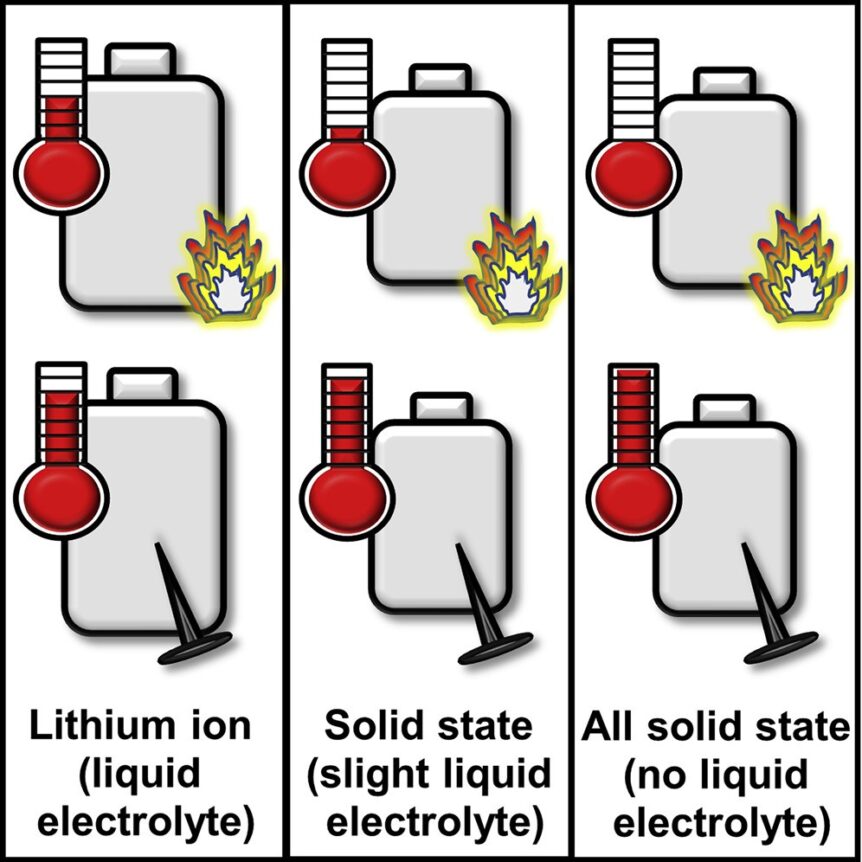What if our assumptions prove wrong? How willing are we to at least examine closely-held beliefs and accept a new, scientific finding? Sandia engineers are demonstrating that solid-state batteries containing a little liquid electrolyte can be safer than conventional lithium-ion cells. PV Buzz included a great executive summary in their article on the findings: A new study tackled a long-held assumption that adding some liquid electrolyte to improve performance would make solid-state batteries unsafe. Instead, the research team found that in many cases solid-state batteries with a little liquid electrolyte were safer than their lithium-ion counterparts. They also found, if the battery were to short-circuit, releasing all its stored energy, the theoretically super-safe, all-solid-state battery could put out a dangerous amount of heat. Those three points seem to contradict the conventional wisdom that eliminating electrolytes would lead to safer, less flammable batteries. Sandia engineers Alex Bates and John Hewson have published findings challenging that conventional wisdom in the peer-reviewed journal …
Lighter, More Powerful, Cheaper. Can J-CESR Bring Us Better Batteries?
$70,000 is a sizable base price for a car. That sum for the simplest of Tesla S sedans makes a bigger than average debt load for most of us, probably more than most can responsibly assume. Even the much anticipated model “E” at half that price is more stunning than the average sticker shock these days. What if, by some act of art or science, that $70,000 could be slashed to $14,000 for an electric vehicle that could travel 265 miles on a charge? That tall order is the order of the day for the Joint Center for Energy Storage Research, started two years ago under Dr. Steven Chu, who was then U. S. Secretary of Energy. He and his “teams” were charged with establishing the cooperative enterprise at “Argonne National Laboratory with a budget of $120 million over five years to create a battery five times more powerful and five times cheaper than today’s norms – all within five …
The New Mythbusters: Slow Charging May Not Make Batteries Last Longer
For the last 60 years, your editor remembers the oft-repeated advice from garage mechanics and now lithium-ion advocates that slow charging is the way to make your batteries last for many cycles. Where does this put Tesla, for instance, with its 20-minute Superchargers? Are you damaging your expensive cells by being in a hurry? In yet another example of counter-intuitive thinking at work, researchers at SLAC, the National Accelerator Laboratory at located on the Stanford University campus have challenged several tenets of conventional battery wisdom. According to PC World, their work, “published on Sunday in the Journal, Nature Materials, challenges the commonly held notion that slowly charging a battery helps prolong its life and that it’s damaging to a battery if a large amount of energy is withdrawn in a short time.” William Chueh, a senior author of the paper and researcher at the Stanford Institute for Materials and Energy Sciences (SIMES), told the magazine, “’We’ve always thought of a …
I’ll Take Manhattan
While much of battery research goes into crafting the ultimate anode, cathode or electrolyte, there seem to be few efforts, at least to outside observers, of integrated approaches to making a better total battery. That may change soon, with the Department of Energy announcing formation of a new Joint Center for Energy Storage Research (J-CESR, or J-Caesar). Dr. Steven Chu, U. S. Secretary of Energy, has established the Center at Argonne National Laboratory with a budget of $120 million over five years to create a battery five times more powerful and five times cheaper than today’s norms – all within five years. For those of us who’ve grown wary of those “breakthough” announcements that almost always include the line, “researchers say the new product could become a commercial reality in the next five to 20 years,” this may seem too hopeful. Secretary Chu’s announcement included several factors that may alleviate this wariness. The Department is putting up the money, …
Solar Cells – All That Glitters Need Not Be Gold
The search for less expensive solar cells drives many lines of research these days, with trends toward smaller collectors and less expensive materials leading the way. Many solar cells use gold and other pricey metals to provide junctions within the cell structure. Gold closed Friday at $1,204.00 per troy ounce on the London Metal Exchange, and nickel at $10.01 per pound. That would make gold worth $17,558 per avoirdupois pound (14.583 troy ounces per pound), or 1,754 times more expensive than nickel. According to Gizmag, University of Toronto investigators found that substituting nickel for the previously used gold as collection contacts in their colloidal quantum dot solar cells provided equal performance, at a 40 to 80-percent drop in solar cell prices. Following that math, current pricing of solar cells such as Ascent’s thin film units at $6.00 per Watt could drop to $2.40 to $1.20 per Watt; near the $1.00 per Watt goal many cell makers have long sought. …

